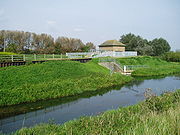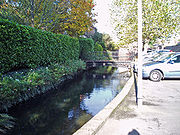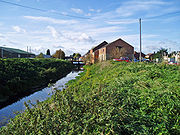
Bourne Eau
Encyclopedia

Bourne, Lincolnshire
Bourne is a market town and civil parish on the western edge of the Fens, in the District of South Kesteven in southern Lincolnshire, England.-The town:...
in Lincolnshire
Lincolnshire
Lincolnshire is a county in the east of England. It borders Norfolk to the south east, Cambridgeshire to the south, Rutland to the south west, Leicestershire and Nottinghamshire to the west, South Yorkshire to the north west, and the East Riding of Yorkshire to the north. It also borders...
, England, and flows in an easterly direction to join the River Glen
River Glen, Lincolnshire
The River Glen is a river in Lincolnshire, England with a short stretch passing through Rutland near Essendine.The river's name appears to derive from a Brythonic Celtic language but there is a strong early English connection.-Naming:...
at Tongue End
Tongue End
Tongue End is a small Lincolnshire village of Victorian redbrick farmworkers' cottages and early 20th century former council houses at . It is located alongside the Counter Drain Between Baston, Bourne, and Pode Hole, spread out along the road...
. It is an embanked river, as its normal level is higher than that of the surrounding Fens. It was navigable in the 18th and 19th century, but now forms an important part of the drainage system that enables the surrounding fen land to be used for agriculture.
Course

Bourne, Lincolnshire
Bourne is a market town and civil parish on the western edge of the Fens, in the District of South Kesteven in southern Lincolnshire, England.-The town:...
. The Wellhead is a natural artesian
Artesian aquifer
An artesian aquifer is a confined aquifer containing groundwater under positive pressure. This causes the water level in a well to rise to a point where hydrostatic equilibrium has been reached. This type of well is called an artesian well...
spring which once formed the source of the water defences of Bourne Castle as well as the power for the town's three mill
Watermill
A watermill is a structure that uses a water wheel or turbine to drive a mechanical process such as flour, lumber or textile production, or metal shaping .- History :...
s. On entering Bourne North Fen it follows an artificial course which it was given, probably, in the first half of the thirteenth century when the south Lincolnshire Fens ceased to be a Royal forest
Royal forest
A royal forest is an area of land with different meanings in England, Wales and Scotland; the term forest does not mean forest as it is understood today, as an area of densely wooded land...
. Hitherto, it had occupied the channel known as the Old Ea which was of Roman
Roman Britain
Roman Britain was the part of the island of Great Britain controlled by the Roman Empire from AD 43 until ca. AD 410.The Romans referred to the imperial province as Britannia, which eventually comprised all of the island of Great Britain south of the fluid frontier with Caledonia...
date, most likely second century.
The present course enters the River Glen
River Glen, Lincolnshire
The River Glen is a river in Lincolnshire, England with a short stretch passing through Rutland near Essendine.The river's name appears to derive from a Brythonic Celtic language but there is a strong early English connection.-Naming:...
at , a name which derives from the low tongue of land within the enclosing banks of the rivers.
Apart from the spring, most of the water
Water
Water is a chemical substance with the chemical formula H2O. A water molecule contains one oxygen and two hydrogen atoms connected by covalent bonds. Water is a liquid at ambient conditions, but it often co-exists on Earth with its solid state, ice, and gaseous state . Water also exists in a...
of the river
River
A river is a natural watercourse, usually freshwater, flowing towards an ocean, a lake, a sea, or another river. In a few cases, a river simply flows into the ground or dries up completely before reaching another body of water. Small rivers may also be called by several other names, including...
is collected by the Car Dyke
Car Dyke
The Car Dyke was, and to large extent still is, an eighty-five mile long ditch which runs along the western edge of the Fens in eastern England. It is generally accepted as being of Roman age and, for many centuries, to have been taken as marking the western edge of the Fens...
, which, near Bourne, is arranged to act as a catchwater drain
Catchwater drain
A catchwater drain is a land drain, a ditch cut across the fall of the land, typically just above the level of low-lying, level ground such as The Fens of eastern England, where some land, tens of kilometres from the sea is at about sea level...
, gathering the surface water of the upland and feeding it via the Bourne Eau and River Glen to the sea
Sea
A sea generally refers to a large body of salt water, but the term is used in other contexts as well. Most commonly, it means a large expanse of saline water connected with an ocean, and is commonly used as a synonym for ocean...
, without its entering The Fens
The Fens
The Fens, also known as the , are a naturally marshy region in eastern England. Most of the fens were drained several centuries ago, resulting in a flat, damp, low-lying agricultural region....
.
History

Act of Parliament
An Act of Parliament is a statute enacted as primary legislation by a national or sub-national parliament. In the Republic of Ireland the term Act of the Oireachtas is used, and in the United States the term Act of Congress is used.In Commonwealth countries, the term is used both in a narrow...
, to construct the Black Sluice where the South Forty-Foot Drain
South Forty-foot drain
The South Forty-Foot Drain is the main channel for the land-drainage of the Black Sluice Level in the Lincolnshire Fens. It lies in eastern England between Guthram Gowt and the Black Sluice pumping station on The Haven, at Boston...
entered The Haven
The Haven, Boston
The Haven is the tidal river of the Port of Boston, Lincolnshire in England. It provides access for shipping between Boston Deeps in The Wash and the town, particularly, the dock. It also serves as the outfall into the sea, of the River Witham and of several major land drains of the northern Fens...
at Boston
Boston, Lincolnshire
Boston is a town and small port in Lincolnshire, on the east coast of England. It is the largest town of the wider Borough of Boston local government district and had a total population of 55,750 at the 2001 census...
, and to supervise the drainage of the Fens feeding that system. The north bank was a serious problem, as it was built on a peat subsoil, and defied attempts to raise it, with the result that the Bourne Fens often flooded. Improvements to the 3.5 miles (5.6 km) of river from the River Glen junction to the town of Bourne were authorised by an act of Parliament obtained on 29 March 1781, which suggested that the river had previously been navigable, but had become choked with mud. The act created a body of 12 trustees, who were empowered to maintain a channel which was 30 feet (9.1 m) wide by 5 feet (1.5 m) deep. The navigation included two locks, one near the junction with the Glen, and the other near Bourne.
In order to ease the problems caused by the north bank, the Black Sluice Commissioners negotiated with the Trustees to allow them to build a set of flood gates at Tongue End, where the river joined the Glen, and an overfall weir, which allowed surplus water to flow over the bank and into the Weir Dyke in Bourne Fen. The self-acting doors were replaced by a sluice in the 1860s, which effectively brought navigation to an end, and the sluice was replaced by a pumping station in 1966, which removed the need for the overfall weir.
Linguistic derivations
The use of the FrenchFrench language
French is a Romance language spoken as a first language in France, the Romandy region in Switzerland, Wallonia and Brussels in Belgium, Monaco, the regions of Quebec and Acadia in Canada, and by various communities elsewhere. Second-language speakers of French are distributed throughout many parts...
-seeming Eau as the name of a Fenland river is not unique. It appears to have arisen in the eighteenth century. The earlier term was Ea, which arises from an Anglo-Danish
Danish language
Danish is a North Germanic language spoken by around six million people, principally in the country of Denmark. It is also spoken by 50,000 Germans of Danish ethnicity in the northern parts of Schleswig-Holstein, Germany, where it holds the status of minority language...
word for river. Compare the Danish aa, nowadays written å. This Danish, one-letter word is pronounced as a French o but shortened by a glottal stop or as a curt English
English language
English is a West Germanic language that arose in the Anglo-Saxon kingdoms of England and spread into what was to become south-east Scotland under the influence of the Anglian medieval kingdom of Northumbria...
aw as a pure vowel
Vowel
In phonetics, a vowel is a sound in spoken language, such as English ah! or oh! , pronounced with an open vocal tract so that there is no build-up of air pressure at any point above the glottis. This contrasts with consonants, such as English sh! , where there is a constriction or closure at some...
rather than a diphthong
Diphthong
A diphthong , also known as a gliding vowel, refers to two adjacent vowel sounds occurring within the same syllable. Technically, a diphthong is a vowel with two different targets: That is, the tongue moves during the pronunciation of the vowel...
. The eighteenth century engineer
Civil engineering
Civil engineering is a professional engineering discipline that deals with the design, construction, and maintenance of the physical and naturally built environment, including works like roads, bridges, canals, dams, and buildings...
s and map
Map
A map is a visual representation of an area—a symbolic depiction highlighting relationships between elements of that space such as objects, regions, and themes....
-makers
Cartography
Cartography is the study and practice of making maps. Combining science, aesthetics, and technique, cartography builds on the premise that reality can be modeled in ways that communicate spatial information effectively.The fundamental problems of traditional cartography are to:*Set the map's...
seem to have been more familiar with French than with Danish. However, in the German-speaking parts of Schleswig-Holstein, rivers which across the border in Denmark, fit this nomenclature are called Au, which is not widely different from the English pronunciation of Eau.
The following is extracted from the Wikipedia article on Aachen
Aachen
Aachen has historically been a spa town in North Rhine-Westphalia, Germany. Aachen was a favoured residence of Charlemagne, and the place of coronation of the Kings of Germany. Geographically, Aachen is the westernmost town of Germany, located along its borders with Belgium and the Netherlands, ...
. "The Roman
Roman Britain
Roman Britain was the part of the island of Great Britain controlled by the Roman Empire from AD 43 until ca. AD 410.The Romans referred to the imperial province as Britannia, which eventually comprised all of the island of Great Britain south of the fluid frontier with Caledonia...
s named the hot sulphur springs there, Aquis-Granum. For the origin of the Granus several theories were developed, but it is now widely accepted that it derives from the Celt
Celt
The Celts were a diverse group of tribal societies in Iron Age and Roman-era Europe who spoke Celtic languages.The earliest archaeological culture commonly accepted as Celtic, or rather Proto-Celtic, was the central European Hallstatt culture , named for the rich grave finds in Hallstatt, Austria....
ic god
Deity
A deity is a recognized preternatural or supernatural immortal being, who may be thought of as holy, divine, or sacred, held in high regard, and respected by believers....
of water
Water
Water is a chemical substance with the chemical formula H2O. A water molecule contains one oxygen and two hydrogen atoms connected by covalent bonds. Water is a liquid at ambient conditions, but it often co-exists on Earth with its solid state, ice, and gaseous state . Water also exists in a...
and health
Health
Health is the level of functional or metabolic efficiency of a living being. In humans, it is the general condition of a person's mind, body and spirit, usually meaning to be free from illness, injury or pain...
. The hot springs have been channelled into baths since Roman times, and these are still in use. The element ‘’âh’’- is an Old German
German language
German is a West Germanic language, related to and classified alongside English and Dutch. With an estimated 90 – 98 million native speakers, German is one of the world's major languages and is the most widely-spoken first language in the European Union....
cognate with Latin
Latin
Latin is an Italic language originally spoken in Latium and Ancient Rome. It, along with most European languages, is a descendant of the ancient Proto-Indo-European language. Although it is considered a dead language, a number of scholars and members of the Christian clergy speak it fluently, and...
‘’aqua’’, both meaning "water". In French-speaking areas of the former Empire
Roman Empire
The Roman Empire was the post-Republican period of the ancient Roman civilization, characterised by an autocratic form of government and large territorial holdings in Europe and around the Mediterranean....
the word ‘’aquas’’ was turned into ‘’aix’’, hence Aix-en-Provence
Aix-en-Provence
Aix , or Aix-en-Provence to distinguish it from other cities built over hot springs, is a city-commune in southern France, some north of Marseille. It is in the region of Provence-Alpes-Côte d'Azur, in the département of Bouches-du-Rhône, of which it is a subprefecture. The population of Aix is...
is an old Roman spa in Provence." Thus, the use of the French word for water, eau is not after all, so inappropriate.
A bourne is a stream flowing from a spring. Thus, although the town in which it rises is called Bourne and this apparently gives rise to the river's name, the Bourne Eau is clearly the bourne in question. Bourne is the southern English cognate of the burn of northern English. However, in later use, each has begun to lose its association with the spring, burn the more so.
Wheeler gives the name Bourne Old Ea to what is now the Bourne Eau
Bourne Eau
Bourne Eau is a short river which rises in the town of Bourne in Lincolnshire, England, and flows in an easterly direction to join the River Glen at Tongue End. It is an embanked river, as its normal level is higher than that of the surrounding Fens...
and Bourne Ea or Brunne Ea to that part of the Glen
River Glen, Lincolnshire
The River Glen is a river in Lincolnshire, England with a short stretch passing through Rutland near Essendine.The river's name appears to derive from a Brythonic Celtic language but there is a strong early English connection.-Naming:...
downstream of Kate's Bridge
Kate's Bridge
Kate's Bridge is a landmark settlement on the A15 road, in the parish of Thurlby, about south of Bourne, Lincolnshire, England. Its size is indicated by the fact that the road signs announcing it at its two ends are on the same pole....
. He then quotes Dugdale
William Dugdale
Sir William Dugdale was an English antiquary and herald. As a scholar he was influential in the development of medieval history as an academic subject.-Life:...
, and an act of Queen Elizabeth I
Elizabeth I of England
Elizabeth I was queen regnant of England and Ireland from 17 November 1558 until her death. Sometimes called The Virgin Queen, Gloriana, or Good Queen Bess, Elizabeth was the fifth and last monarch of the Tudor dynasty...
:
- Brunne, River of, Brunne Hee,Burne Alde Ee. In Dugdale the Brunne Ee is describhed in the margin as 'now the Glene'...'Which had its course through the midst of the town of Pincbec.' The 'Ware' Dyke is described as extending along 'the river of Burne Ee to Godramscote' in a commission of Sewers held at Hempringingham in Queen Elisabeth's time.
See also
- Aa RiverAa RiverAa River may refer to:* Aa River , a river in northern France* Aa River , a river in North Brabant, Netherlands* Aa of Weerijs, a river in North Brabant, Netherlands* Drentsche Aa, a river in Groningen, Netherlands...
- Bourne-Morton CanalBourne-Morton CanalThe Bourne–Morton Canal is an archaeological feature to the north east of Bourne in Lincolnshire, England. In old maps and documents it is known as the Old Ea. It was a 6.5 km artificial waterway linking the dry ground at Bourne to the ancient edge of the sea near Pinchbeck, or perhaps to a...

